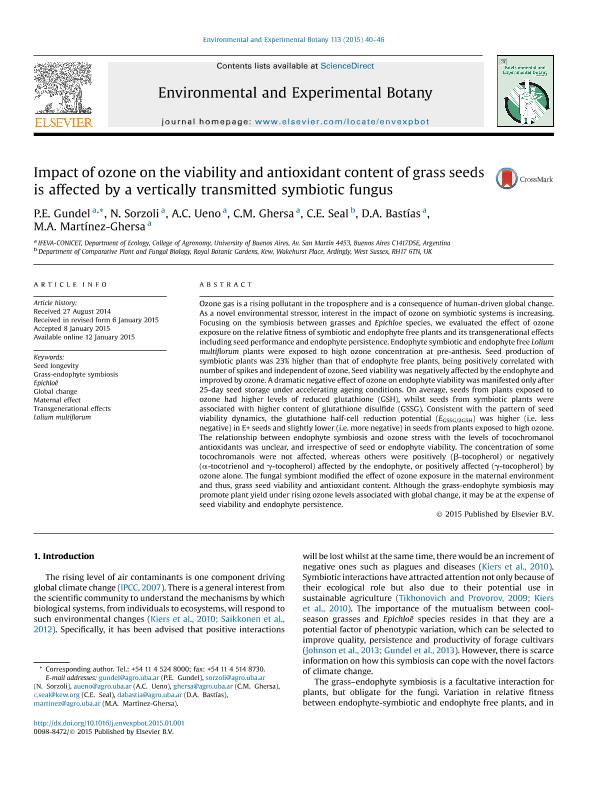Mostrar el registro sencillo del ítem
dc.contributor.author
Gundel, Pedro Emilio

dc.contributor.author
Sorzoli, N.
dc.contributor.author
Ueno, Andrea Celeste
dc.contributor.author
Ghersa, Claudio Marco

dc.contributor.author
Seal, C. E.
dc.contributor.author
Bastias, D. A.
dc.contributor.author
Martinez-Ghersa, Maria Alejandra

dc.date.available
2016-02-05T19:44:37Z
dc.date.issued
2015-01-12
dc.identifier.citation
Gundel, Pedro Emilio; Sorzoli, N.; Ueno, Andrea Celeste; Ghersa, Claudio Marco; Seal, C. E.; et al.; Impact of ozone exposure of the maternal environment on the viability and antioxidant content of grass seeds is affected by a vertically transmitted symbiotic fungus; Elsevier; Environmental and Experimental Botany; 113; 12-1-2015; 40-46
dc.identifier.issn
0098-8472
dc.identifier.uri
http://hdl.handle.net/11336/4084
dc.description.abstract
Ozone gas is a rising pollutant in the troposphere and is a consequence of human-driven global change. As a novel environmental stressor, interest in the impact of ozone on symbiotic systems is increasing. Focusing on the symbiosis between grasses and Epichloe species, we evaluated the effect of ozone exposure on the relative fitness of symbiotic and endophyte free plants and its transgenerational effects including seed performance and endophyte persistence. Endophyte symbiotic and endophyte free Lolium multiflorum plants were exposed to high ozone concentration at pre-anthesis. Seed production of symbiotic plants was 23% higher than that of endophyte free plants, being positively correlated with number of spikes and independent of ozone. Seed viability was negatively affected by the endophyte and improved by ozone. A dramatic negative effect of ozone on endophyte viability was manifested only after 25-day seed storage under accelerating ageing conditions. On average, seeds from plants exposed to ozone had higher levels of reduced glutathione (GSH), whilst seeds from symbiotic plants were associated with higher content of glutathione disulfide (GSSG). Consistent with the pattern of seed viability dynamics, the glutathione half-cell reduction potential (EGSSG/2GSH) was higher (i.e. less negative) in E+ seeds and slightly lower (i.e. more negative) in seeds from plants exposed to high ozone. The relationship between endophyte symbiosis and ozone stress with the levels of tocochromanol antioxidants was unclear, and irrespective of seed or endophyte viability. The concentration of some tocochromanols were not affected, whereas others were positively (b-tocopherol) or negatively (a-tocotrienol and g-tocopherol) affected by the endophyte, or positively affected (g-tocopherol) by ozone alone. The fungal symbiont modified the effect of ozone exposure in the maternal environment and thus, grass seed viability and antioxidant content. Although the grass-endophyte symbiosis may promote plant yield under rising ozone levels associated with global change, it may be at the expense of seed viability and endophyte persistence.
dc.format
application/pdf
dc.language.iso
eng
dc.publisher
Elsevier

dc.rights
info:eu-repo/semantics/openAccess
dc.rights.uri
https://creativecommons.org/licenses/by-nc-nd/2.5/ar/
dc.subject
Seeds
dc.subject
Ozone
dc.subject
Antioxidants
dc.subject
Endophyte
dc.subject.classification
Micología

dc.subject.classification
Ciencias Biológicas

dc.subject.classification
CIENCIAS NATURALES Y EXACTAS

dc.subject.classification
Ciencias de las Plantas, Botánica

dc.subject.classification
Ciencias Biológicas

dc.subject.classification
CIENCIAS NATURALES Y EXACTAS

dc.title
Impact of ozone exposure of the maternal environment on the viability and antioxidant content of grass seeds is affected by a vertically transmitted symbiotic fungus
dc.type
info:eu-repo/semantics/article
dc.type
info:ar-repo/semantics/artículo
dc.type
info:eu-repo/semantics/publishedVersion
dc.date.updated
2016-03-30 10:35:44.97925-03
dc.journal.volume
113
dc.journal.pagination
40-46
dc.journal.pais
Países Bajos

dc.journal.ciudad
Amsterdam
dc.description.fil
Fil: Gundel, Pedro Emilio. Consejo Nacional de Investigaciones Científicas y Técnicas. Oficina de Coordinación Administrativa Parque Centenario. Instituto de Investigaciones Fisiológicas y Ecológicas Vinculadas a la Agricultura; Argentina
dc.description.fil
Fil: Sorzoli, N.. Consejo Nacional de Investigaciones Científicas y Técnicas. Oficina de Coordinación Administrativa Parque Centenario. Instituto de Investigaciones Fisiológicas y Ecológicas Vinculadas a la Agricultura; Argentina
dc.description.fil
Fil: Ueno, Andrea Celeste. Consejo Nacional de Investigaciones Científicas y Técnicas. Oficina de Coordinación Administrativa Parque Centenario. Instituto de Investigaciones Fisiológicas y Ecológicas Vinculadas a la Agricultura; Argentina
dc.description.fil
Fil: Ghersa, Claudio Marco. Consejo Nacional de Investigaciones Científicas y Técnicas. Oficina de Coordinación Administrativa Parque Centenario. Instituto de Investigaciones Fisiológicas y Ecológicas Vinculadas a la Agricultura; Argentina
dc.description.fil
Fil: Seal, C. E.. Royal Botanic Gardens. Department of Comparative Plant and Fungal Biology; Reino Unido
dc.description.fil
Fil: Bastias, D. A.. Consejo Nacional de Investigaciones Científicas y Técnicas. Oficina de Coordinación Administrativa Parque Centenario. Instituto de Investigaciones Fisiológicas y Ecológicas Vinculadas a la Agricultura; Argentina
dc.description.fil
Fil: Martinez-Ghersa, Maria Alejandra. Consejo Nacional de Investigaciones Científicas y Técnicas. Oficina de Coordinación Administrativa Parque Centenario. Instituto de Investigaciones Fisiológicas y Ecológicas Vinculadas a la Agricultura; Argentina
dc.journal.title
Environmental and Experimental Botany

dc.relation.alternativeid
info:eu-repo/semantics/altIdentifier/url/http://www.sciencedirect.com/science/article/pii/S0098847215000106
dc.relation.alternativeid
info:eu-repo/semantics/altIdentifier/issn/0098-8472
dc.relation.alternativeid
info:eu-repo/semantics/altIdentifier/doi/http://dx.doi.org/10.1016/j.envexpbot.2015.01.001
Archivos asociados
